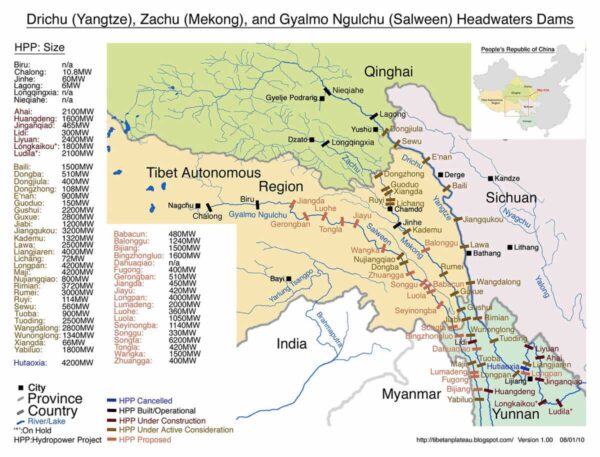
A law passed by Congress will for the first time require the State Department to report on the impact of changing water flows and Chinese dams on the Mekong (Tibetan: Dzachu) River and Tibetan plateau.
The requirement for the report is part of the explanatory statement accompanying the spending bill that Congress passed on Dec. 21, 2020. It mandates that the secretary of state submit the Mekong River Report to the appropriate Congressional committees within 180 days.
The report—which the secretary must produce in consultation with the administrator of the US Agency for International Development, the director of national intelligence and the heads of other relevant federal agencies—must analyze the effect of water flow changes on the Mekong and the Tibetan plateau watershed, including the effect of upriver dams. The Mekong originates in Tibet.
In recent years, the Chinese government has begun a flurry of dam construction in Tibet, which provides water to more than 1 billion people downstream. Thanks in part to China’s reckless development policies, Tibet is warming nearly three times faster than the global average.
The report should see how those changes affect the political and economic stability of Lower Mekong countries, according to the bill.
Water security in Tibet
The mandate for the new report is another sign of growing international concern about water security in Tibet, which China annexed more than 60 years ago and continues to rule with an iron fist.
Earlier this year, Eyes on Earth Inc. published a study showing that China used its dams on the Mekong to prevent the flow of water downstream in 2019, contributing to a severe drought in Southeast Asia that robbed farmers and fishers of their livelihoods. The drought dried up parts of the river completely.
Just last month, reports emerged that China would construct a new “super” dam on the Yarlung Tsangpo river in Tibet near the border with India, which the Yarlung Tsangpo flows into as the Brahmaputra.
China has become increasingly aggressive with India at the Indo-Tibetan border, leading to a bloody clash between Chinese and Indian troops in June.
ICT reports
Over the past few years, ICT has published several reports documenting the danger of China’s dam construction and water flow manipulation in Tibet.
In 2015, ICT’s “Blue Gold from the Highest Plateau: Tibet’s Water and Global Climate Change,” chronicled how the Chinese government diverted and stemmed the flow of Tibet’s rivers to support Chinese electricity generation, mining and other economic activities.
The report also described how China massively dammed Tibet’s rivers, including the Mekong, while at the same time refusing to join any international mechanism regulating the flow of rivers in the region, thereby depriving other countries of life-saving information.
Last year, ICT’s report, “Damming Tibet’s Rivers: New Threats to Tibetan Area under UNESCO Protection,” revealed the construction of dams and infrastructure in Tibet that could impact a biodiverse area known as the “Three Parallel Rivers,” which is the source of the Mekong.
Bill text
Below is the full text of the section of the spending bill that mandates the new report:
“Not later than 180 days after enactment of the act, the Secretary of State, in consultation with the USAID Administrator, the Director of National Intelligence, and the heads of other relevant Federal agencies, shall submit a report to the appropriate congressional committees on how changing water flows of the Mekong River and the Tibetan Plateau watershed impact the political and economic stability of the Lower Mekong countries.”
Quote
International Campaign for Tibet Vice-President Bhuchung Tsering:
“As China’s policies in the Indo-Pacific region increasingly threaten security and stability, the Tibetan Plateau and its rivers’ system become more crucial. The US and other governments should pay attention to China’s policies in the Tibetan plateau, as over a billion people depend on its waters, which are managed without transparency and cooperation by Beijing. The report on the Mekong and Tibetan plateau is an important first step and one that will provide vital information for confronting this danger to the entire world.”

